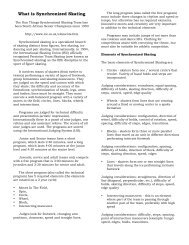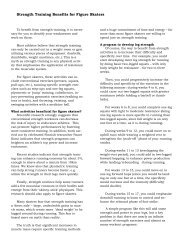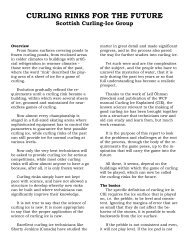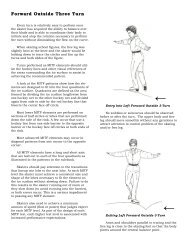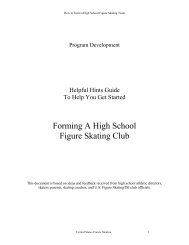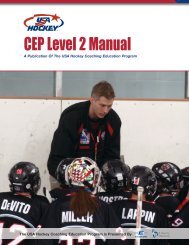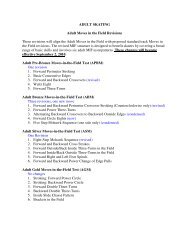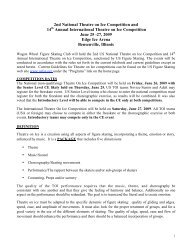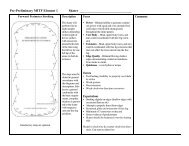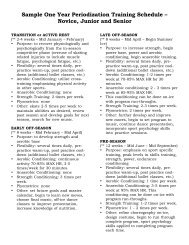CEP Level 3 Manual - Rushmore Hockey Association
CEP Level 3 Manual - Rushmore Hockey Association
CEP Level 3 Manual - Rushmore Hockey Association
You also want an ePaper? Increase the reach of your titles
YUMPU automatically turns print PDFs into web optimized ePapers that Google loves.
T A B L E O F C O N T E N T SPLYOMETRICS AND AGILITIESPLYOMETRICSPlyometrics is the movement/activity thatbridges the gap between strength and speed byutilizing the Myotatic Stretch Reflex. This reflex iscalled upon when the muscles are loaded in aneccentric contraction (muscle lengthening) andthen immediately followed by a concentriccontraction (muscle shortening). By performingPlyometrics, the hips, knees, and ankles are worked.It is imperative that a strong base strength isdeveloped before a program is started. Exercisesinclude jumps, hops, bounds, leaps, skips, throws,and pushes. When performing these exercises, thegoal is to train the nervous system to reactexplosively with maximal force production.Teaching muscles how to absorb shock also aids ininjury prevention.A. All plyometric and agility drills should besupervised.B. Drills should be done for quality, not quantity(minimal foot/skate contacts, maximumintensity and quality of movement).C. Athletes should be able to squat 1.5 timestheir body weight before engaging in anintense plyometric program.D. Low level, double leg exercises must precedeany higher level single leg movements.E. As strength level increases, plyometricintensities should increase.F. Do not perform to fatigue, allow forcomplete recovery time.G. Maintain core stability and perfect postureduring exercises.H. When dry land training, be sure to wear theproper foot wear and have a shock absorbingsurface.I. Movements should be as sport specific aspossible.J. Plyometrics for the same body part shouldnot be performed on consecutive days.K. Always perform a proper warm up andflexibility program.There is a long list of plyometrics that an athletecan perform. The following are basic and veryproductive as long as they are performed correctly.Know your limitations and the stage of training thatyou are at.Low <strong>Level</strong>1. Jump Rope - use different variations andpatterns to get the most out of this exercise.Start double legged and proceed to single legvariations.2. Squat Jumps - same as a regular squat butnow we are leaving the ground, with perfectform, performing the jumps continuously.3. Tuck Jumps - standing with feet together,jump up bringing knees to chest, variationsinclude heels to butt, include 90, 180, 270degree turns, performed continuously.4. Box Jumps - start with a low box 18” proceedto a higher one 24” - 36”, jump onto the boxmaking sure the landing is soft and quiet, trynot to bottom out.5. Skipping - a basic fundamental movementthat involves coordination and explosiveness,involves jumping from one foot to the other.Medium/High Intensity1. Explosive Step Ups - start with one foot onthe box and drive up as high as possible,switching feet in air. Use variations such asalternating lateral step ups.2. Ice Skaters - lateral hops from one leg to theother, use different variations such as stickand hold, continuous, two bounces and go.3. Lateral & Forward Cone/Hurdle Hops - setup cones/hurdles, start with two feet moving,hopping forward, switch to one foot landingsas you progress. Change to lateral directionon two feet, changing direction, alternatingone foot or two feet.4. Broad Jumps - jumping on two feet fordistance, use variations such as stick andhold, continuous.5. Hurdle/Barrier Hops - try jumping for heightoff of two feet, landing soft and holding ormore advanced should try continuous hops.6. Lunge Jumps/Slip Squat Jumps - out of alunge position, try to get as vertical aspossible.AGILITIESAgilities are drills that emphasize the ability torapidly and efficiently change direction whilecontrolling the body’s center of gravity.A. Should be as sport specific as possible.B. Quality, not quantity, they should not beconditioning drills.C. Combine agility training with balance,reflexes, anticipation and hand-eyecoordination.D. Should be monitored by coach or otherinstructor.E. Begin with proper warm up and flexibilityprogram.1. Agility Ladder drills - work on foot quickness,changes of directions, body awareness andcontrol. Serves as a great warm up. Use avariation of slides, twists, skips, crossoversteps, and shuffle. Let the imagination adjustthe movements to as sport specific aspossible.2. W Drill - 5 cones are set up in the shape of a“W”, vary the spacing between cones. Startfacing down the line (looking at all cones).Move by shuffling, sliding, sprinting,backpedaling, and/or any other movementdesired. Control the body’s center of gravityas each cone is reached and then changedirection to the next cone.3. Pro Agility/”NFL Shuttle” - use 3 cones, tape,lines on a field/ice spaced five yards apart.Start on middle line/cone/tape. Oncommand/own action, sprint to either side,touch the line, change direction, sprint tenyards back to the other side, touch, changedirection, and cross the middle line again.Sprint, shuffle, or backpedal. Try to improveyour time on each rep.4. Jump Rope/Dot Drill - also a great agilityworkout, adding different foot work andcombinations. Great for the improvement ofcoordination.150 | USA <strong>Hockey</strong> Coaching Education Program <strong>Level</strong> 3 <strong>Manual</strong>Growth and Fitness Development | 151



